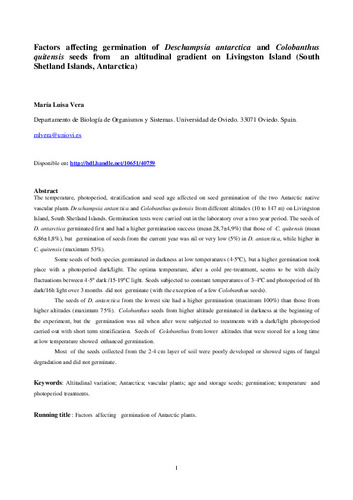Factors affecting germination of Deschampsia antarctica and Colobanthus quitensis seeds from an altitudinal gradient on Livingston Island (South Shetland Islands, Antarctica)
Autor(es) y otros:
Palabra(s) clave:
Altitudinal variation
Antarctica
Vascular plants
Age and storage seeds
Germination
Temperature and photoperiod treatments
Fecha de publicación:
Descripción física:
Resumen:
The temperature, photoperiod, stratification and seed age affected on seed germination of the two Antarctic native vascular plants Deschampsia antarctica and Colobanthus quitensis from different altitudes (10 to 147 m) on Livingston Island, South Shetland Islands. Germination tests were carried out in the laboratory over a two year period. The seeds of D. antarctica germinated first and had a higher germination success (mean 28,7±4,9%) that those of C. quitensis (mean 6,86±1,8%), but germination of seeds from the current year was nil or very low (5%) in D. antarctica, while higher in C. quitensis (maximum 53%). Some seeds of both species germinated in darkness at low temperatures (4-5ºC), but a higher germination took place with a photoperiod dark/light. The optima temperature, after a cold pre-treatment, seems to be with daily fluctuations between 4-5º dark /15-19ºC light. Seeds subjected to constant temperatures of 3-4ºC and photoperiod of 8h dark/16h light over 3 months did not germinate (with the exception of a few Colobanthus seeds). The seeds of D. antarctica from the lowest site had a higher germination (maximum 100%) than those from higher altitudes (maximum 75%). Colobanthus seeds from higher altitude germinated in darkness at the beginning of the experiment, but the germination was nil when after were subjected to treatments with a dark/light photoperiod carried out with short term stratification. Seeds of Colobanthus from lower altitudes that were stored for a long time at low temperature showed enhanced germination. Most of the seeds collected from the 2-4 cm layer of soil were poorly developed or showed signs of fungal degradation and did not germinate.
The temperature, photoperiod, stratification and seed age affected on seed germination of the two Antarctic native vascular plants Deschampsia antarctica and Colobanthus quitensis from different altitudes (10 to 147 m) on Livingston Island, South Shetland Islands. Germination tests were carried out in the laboratory over a two year period. The seeds of D. antarctica germinated first and had a higher germination success (mean 28,7±4,9%) that those of C. quitensis (mean 6,86±1,8%), but germination of seeds from the current year was nil or very low (5%) in D. antarctica, while higher in C. quitensis (maximum 53%). Some seeds of both species germinated in darkness at low temperatures (4-5ºC), but a higher germination took place with a photoperiod dark/light. The optima temperature, after a cold pre-treatment, seems to be with daily fluctuations between 4-5º dark /15-19ºC light. Seeds subjected to constant temperatures of 3-4ºC and photoperiod of 8h dark/16h light over 3 months did not germinate (with the exception of a few Colobanthus seeds). The seeds of D. antarctica from the lowest site had a higher germination (maximum 100%) than those from higher altitudes (maximum 75%). Colobanthus seeds from higher altitude germinated in darkness at the beginning of the experiment, but the germination was nil when after were subjected to treatments with a dark/light photoperiod carried out with short term stratification. Seeds of Colobanthus from lower altitudes that were stored for a long time at low temperature showed enhanced germination. Most of the seeds collected from the 2-4 cm layer of soil were poorly developed or showed signs of fungal degradation and did not germinate.
Colecciones
- Artículos [37548]
- Biología de Organismos y Sistemas [776]
Ficheros en el ítem





